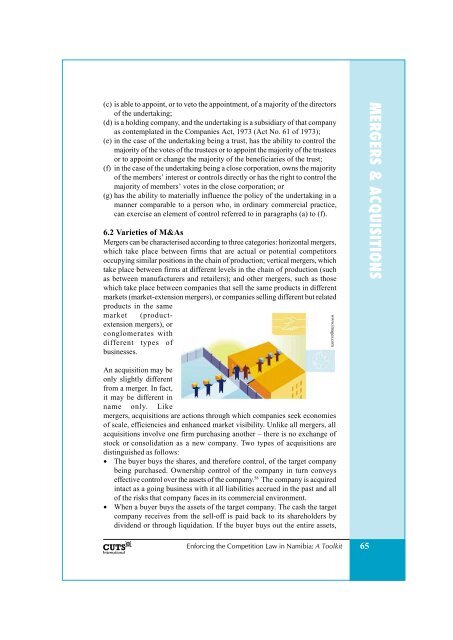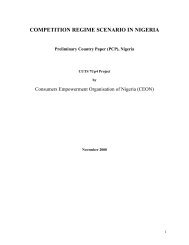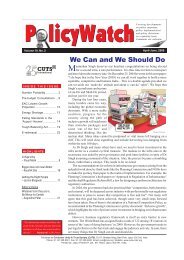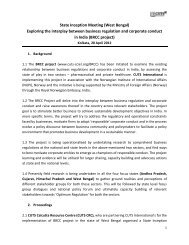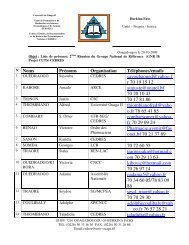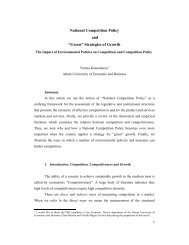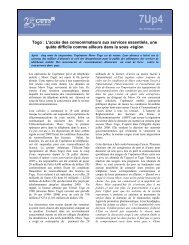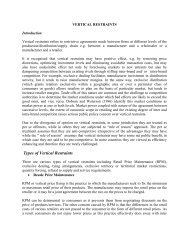Enforcing the Competition Law in Namibia A Toolkit - cuts ccier
Enforcing the Competition Law in Namibia A Toolkit - cuts ccier
Enforcing the Competition Law in Namibia A Toolkit - cuts ccier
Create successful ePaper yourself
Turn your PDF publications into a flip-book with our unique Google optimized e-Paper software.
(c) is able to appo<strong>in</strong>t, or to veto <strong>the</strong> appo<strong>in</strong>tment, of a majority of <strong>the</strong> directorsof <strong>the</strong> undertak<strong>in</strong>g;(d) is a hold<strong>in</strong>g company, and <strong>the</strong> undertak<strong>in</strong>g is a subsidiary of that companyas contemplated <strong>in</strong> <strong>the</strong> Companies Act, 1973 (Act No. 61 of 1973);(e) <strong>in</strong> <strong>the</strong> case of <strong>the</strong> undertak<strong>in</strong>g be<strong>in</strong>g a trust, has <strong>the</strong> ability to control <strong>the</strong>majority of <strong>the</strong> votes of <strong>the</strong> trustees or to appo<strong>in</strong>t <strong>the</strong> majority of <strong>the</strong> trusteesor to appo<strong>in</strong>t or change <strong>the</strong> majority of <strong>the</strong> beneficiaries of <strong>the</strong> trust;(f) <strong>in</strong> <strong>the</strong> case of <strong>the</strong> undertak<strong>in</strong>g be<strong>in</strong>g a close corporation, owns <strong>the</strong> majorityof <strong>the</strong> members’ <strong>in</strong>terest or controls directly or has <strong>the</strong> right to control <strong>the</strong>majority of members’ votes <strong>in</strong> <strong>the</strong> close corporation; or(g) has <strong>the</strong> ability to materially <strong>in</strong>fluence <strong>the</strong> policy of <strong>the</strong> undertak<strong>in</strong>g <strong>in</strong> amanner comparable to a person who, <strong>in</strong> ord<strong>in</strong>ary commercial practice,can exercise an element of control referred to <strong>in</strong> paragraphs (a) to (f).6.2 Varieties of M&AsMergers can be characterised accord<strong>in</strong>g to three categories: horizontal mergers,which take place between firms that are actual or potential competitorsoccupy<strong>in</strong>g similar positions <strong>in</strong> <strong>the</strong> cha<strong>in</strong> of production; vertical mergers, whichtake place between firms at different levels <strong>in</strong> <strong>the</strong> cha<strong>in</strong> of production (suchas between manufacturers and retailers); and o<strong>the</strong>r mergers, such as thosewhich take place between companies that sell <strong>the</strong> same products <strong>in</strong> differentmarkets (market-extension mergers), or companies sell<strong>in</strong>g different but relatedproducts <strong>in</strong> <strong>the</strong> samemarket (productextensionmergers), orconglomerates withdifferent types ofbus<strong>in</strong>esses.www.images.comMERGERS & ACQUISITIONSAn acquisition may beonly slightly differentfrom a merger. In fact,it may be different <strong>in</strong>name only. Likemergers, acquisitions are actions through which companies seek economiesof scale, efficiencies and enhanced market visibility. Unlike all mergers, allacquisitions <strong>in</strong>volve one firm purchas<strong>in</strong>g ano<strong>the</strong>r – <strong>the</strong>re is no exchange ofstock or consolidation as a new company. Two types of acquisitions aredist<strong>in</strong>guished as follows:• The buyer buys <strong>the</strong> shares, and <strong>the</strong>refore control, of <strong>the</strong> target companybe<strong>in</strong>g purchased. Ownership control of <strong>the</strong> company <strong>in</strong> turn conveyseffective control over <strong>the</strong> assets of <strong>the</strong> company. 58 The company is acquired<strong>in</strong>tact as a go<strong>in</strong>g bus<strong>in</strong>ess with it all liabilities accrued <strong>in</strong> <strong>the</strong> past and allof <strong>the</strong> risks that company faces <strong>in</strong> its commercial environment.• When a buyer buys <strong>the</strong> assets of <strong>the</strong> target company. The cash <strong>the</strong> targetcompany receives from <strong>the</strong> sell-off is paid back to its shareholders bydividend or through liquidation. If <strong>the</strong> buyer buys out <strong>the</strong> entire assets,<strong>Enforc<strong>in</strong>g</strong> <strong>the</strong> <strong>Competition</strong> <strong>Law</strong> <strong>in</strong> <strong>Namibia</strong>: A <strong>Toolkit</strong> 65


